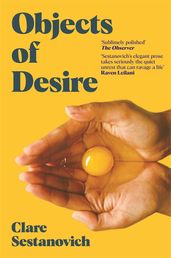Synopsis
Named a ‘Most Anticipated Book of 2021’ by Lit Hub and The Millions
'Sestanovich’s elegant prose takes seriously the quiet unrest that can ravage a life' - Raven Leilani, author of Luster
‘Astonishing – one of the best story collections I’ve read in a long time’ Brandon Taylor, Booker-shortlisted author of Real Life
A college freshman, flying home, strikes up an odd, ephemeral friendship with the couple next to her on the airplane. A long-lost stepbrother’s visit to New York prompts a reckoning with a family’s old taboos. An office worker, exhausted by the ambitions of the men around her, emerges into the gridlocked city one afternoon to make a decision. A wife, looking at her husband's passwords neatly posted on the wall, realizes there are no secrets left in their marriage.
In these eleven short stories, thrilling desire and melancholic yearning animate women’s lives – from the brink of adulthood, to the labyrinthine path between twenty and thirty, to middle age, when certain possibilities quietly elapse. With powerful observation and mordant humour, Clare Sestanovich opens up a fictional world where intimate and uncomfortable truths lie hidden in plain sight.
Objects of Desire is a book pulsing with subtle drama, rich with unforgettable scenes and alive with moments of recognition, each more startling than the last – a spellbinding, brilliant debut.
Details
Reviews
Sestanovich’s elegant prose takes seriously the quiet unrest that can ravage a life, and makes room for the pleasure and discovery that can be found in that ruin
Sublimely polished . . . If it sometimes feels as if we get no closer to these immaculately drawn characters than the eavesdropper on the next table, it’s worth noting that they’re partly estranged from their own lives, or at least from the moments that Sestanovich captures so commandingly. In this way, her pleasurable, discrete dramas achieve something extra: along with their acute social observations and pithy elegance, they collectively probe the gap between how we’re seen and how we might long to appear.
Sestanovich's steady hand and bone-clean prose recall such foremothers as Joan Didion, Zadie Smith, and Jhumpa Lahiri . . . She revitalizes James Joyce’s style of ‘scrupulous meanness’—depicting the setting and inhabitants of her narratives in an ultrarealistic, if sometimes unforgiving, light. Moments of epiphany, or at least self-understanding, accompany everyday activities. . . . Sestanovich engages self-consciously with a matriarchal literary lineage. She weaves each narrative around universal trials of womanhood. Through hysterectomies, miscarriages, and unstable relationships, her cast of canny protagonists come to terms with their wants and needs
Sestanovich is an extraordinary noticer. Carefully, sparely, she parses layers of feeling and attitude; of the tiny ways we admit or refuse love; of incremental, almost invisible, losses of self

